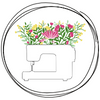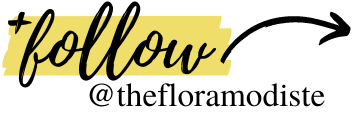How To Read A Sewing Pattern
When starting a new sewing project, I know it may seem like a pretty daunting task trying to figure out how to read a sewing pattern. Every pattern is unique and every project is unique. Maybe you don't even know that you need a sewing pattern in order to sew up a garment? (Girl, it's okay--we've all been there, trust me.)
The not knowing is completely normal, so please don't get discouraged. As they say in meditation: This is simply beginner's mind. Which isn't necessarily a bad thing--none of us are born knowing how to do anything. Allowing yourself the space and the kindness to learn is the only way to grow--not only as a seamstress (ahem, modiste) but as a human being.

Think of a sewing pattern as the foundation for any garment--it's the outline, the template, a blueprint. Sewing patterns are hand drawn by pattern drafters, according to the design and ideas that a fashion designer has put forth.
Wherever there are seams in a garment, that is where two individual pattern pieces have been sewn together. Before these pieces are sewn together, they are individual pieces--individual pieces that are first drawn on paper, pinned to fabric, and then cut accordingly. After being cut out, the different pieces can then be sewn together.
(Love sewing, but have no idea where to start? Building your own sewing kit is an excellent first step! Grab your free, printable worksheet below and start learning how to sew today.)
So. This post is going to walk you through how to read a sewing pattern--from the packaging to the instructions to the sewing pattern itself. And while all sewing patterns are different, they pretty much follow the same basic template and contain the same relevant information needed for a sewing project.
When I originally wrote this post a few years back (it really needed some love, so I decided to come back to it this week!) I had pulled a vintage sewing pattern to walk through how to read a sewing pattern. This was before I had developed our own patterns here at TFM: The Dany and the Jupiter.

Personally, I think our sewing patterns are much less messy than traditional sewing patterns, containing only the information you need to cut and sew a project--hopefully lessening the overwhelm that can come when starting a new sewing project and trying to figure out how to read a sewing pattern from a new company.
While our sewing patterns here at TFM definitely do look a bit different compared to those from traditional sewing pattern companies.. I did make sure to include all of the relevant information included in all traditional sewing patterns--I just made ours better. (Curious about our sewing patterns? Check out the shop now!)
(Love sewing, but have no idea where to start? Building your own sewing kit is an excellent first step! Grab your free, printable worksheet below and start learning how to sew today.)
How to read a sewing pattern: The envelope (front)

The envelope packaging for a sewing pattern is multi-functional--the first objective being to keep all of the different pattern pieces in one place. (Once you cut a sewing pattern up, it can all get a bit messy--especially if the pattern includes smaller pieces.) The sewing pattern envelope also shows all of the different pattern design options and measurement details.
The most prominent detail on the front of a sewing pattern envelope is (of course!) the different illustrations showing the design options that are available with the pattern. For the Dany, you can see that there are three different designs that can be sewn up using this one pattern: A sheath dress, a crop top, and a high waisted skirt.
Nowadays, most sewing patterns show both a photograph of the finished design as well as technical illustrations of all the designs that can be sewn up with the pattern. On the Dany, you can see multiple views of me modeling the matching two piece, as well as technical drawings of all three sewing pattern designs.
(Love sewing, but have no idea where to start? Building your own sewing kit is an excellent first step! Grab your free, printable worksheet below and start learning how to sew today.)
How to read a sewing pattern: The envelope (back)

The back of a sewing pattern envelope is where all of the style and measurement details are. (You know, the fun stuff!) The most important things to look for when reading through these more technical details of a sewing pattern include:
- The style letter associated with each particular design: i.e. Style A for the sheath dress, B for the crop top, and C for the high waisted skirt when it comes to the Dany. This is often paired with another (smaller) technical drawing, and is important to know for cutting and sewing.
- The size range of the sewing pattern: Size ranges vary per company and sewing patterns typically only cover a certain range of sizes. Here at TFM, our sewing patterns range from XS-XL and follow standard US sizing.
- Notions/trims needed: If any trims are needed for a design (i.e. Zippers, buttons, etc.) then it will be listed out accordingly, per design option. While no trims are needed for the Dany, they are often needed in other projects.
- Fabric: Certain fabrics work best for certain projects, and a suggestion of what fabric to pick up is typically always listed on a sewing pattern. Make sure to check it out prior to sewing! (For the Dany, I recommend picking up a mid-weight knit!) Also listed is how much fabric to purchase for the project.
(Love sewing, but have no idea where to start? Building your own sewing kit is an excellent first step! Grab your free, printable worksheet below and start learning how to sew today.)
How to read a sewing pattern: The instructions


Every sewing pattern you purchase will have a set of instructions on how to put the garment together. While the layout for instructions is different for every pattern company--for the most part, they all follow a similar template. One in which I have never been a fan of.
I'm talking black and white teeny tiny text that uses up as little space as possible, no pictures, and confusing technical jargon. So that's pretty much the exact opposite of the instruction manual I developed for TFM sewing patterns--our instructions are in full color, with actual real life photos, and text written in conversational easy-to-understand English.
Some important details to take note of when it comes to instruction manuals:
- The laid out sewing pattern pieces: Make sure to look at all of the pieces that go into a sewing pattern--they are laid out and numbered, showing exactly which pieces goes into each design. (This is important for both cutting & sewing!)
- The cutting marker: This shows you exactly how to lay the cut sewing pattern pieces out on the fabric prior to pinning and cutting. Not only does this ensure that you have enough fabric for your project, but it also reduces fabric waste.
- Seam allowance: Make sure to note what the seam allowance for your pattern is--for TFM patterns, we follow a 1/2" seam allowance.
- The step-by-step sewing process: This includes both written and visual instruction, walking you through the process step by step. If sewing up multiple garments, make sure you're following the correct instructions.
(Love sewing, but have no idea where to start? Building your own sewing kit is an excellent first step! Grab your free, printable worksheet below and start learning how to sew today.)
How to read a sewing pattern: The sewing pattern

And now, for the sewing pattern! As I mentioned above, every sewing pattern is a little different. However, all patterns typically follow a pretty basic template when it comes to the details. A few important things to note include:
- The pattern piece number: Every pattern piece will be labeled with a number--not only does this help with cutting, but it also helps with sewing. (i.e. Referring to pattern piece #1, rather than the Center Front Upper Bodice. Although that's listed on the sewing pattern too!)
- The pattern piece letter: This refers to the sewing pattern style--i.e. A for the sheath dress, B for the crop top, and C for the high waisted skirt. Not every pattern piece is needed for each design, so only cut what you need!
- How many pieces to cut: This is pretty self explanatory--just make sure to pay attention to which pieces should be cut on the fold and which to cut regularly.
- The size range: This is pretty basic for TFM patterns--we follow the standard US size range of XS-XL. The sizes are marked throughout the pattern, so make sure to cut the size you need prior to pinning and cutting in your final fabric.
- Long vertical grain line: This line simply indicates in which direction the pattern piece should be pinned and cut. Pretty much all of our pattern pieces here at TFM are cut along the grain, which makes for easy pinning and cutting.
- Notches: The tiny little horizontal dash marks are there to help you match your pattern pieces when sewing. When cutting in your final fabric, snip the little horizontal lines were indicated. (Making sure to stay within the seam allowance!)
(Love sewing, but have no idea where to start? Building your own sewing kit is an excellent first step! Grab your free, printable worksheet below and start learning how to sew today.)
How to read a sewing pattern: Are you ready?!
When first starting out with learning how to read a sewing pattern, or when using a pattern from a new company, I would highly recommend reading the envelope and instructions carefully. As time passes, you most likely won't even really need to follow either the envelope or instructions--but it's always good to follow them when beginning to work with sewing patterns.
Better safe than sorry, am I right?
When it comes to TFM sewing patterns, I developed them with an absolute newbie in mind--but also kept in mind lessons I myself had learned from working with traditional patterns. I wanted to make the process as easy as possible--while also trying to limit unnecessary details that can sometimes lead to overwhelm.
Have any questions on TFM sewing patterns? Don't hesitate to ask! And make sure to check out the pattern shop for both sewing patterns and complete DIY kits. You got this girl!
(Love sewing, but have no idea where to start? Building your own sewing kit is an excellent first step! Grab your free, printable worksheet below and start learning how to sew today.)






